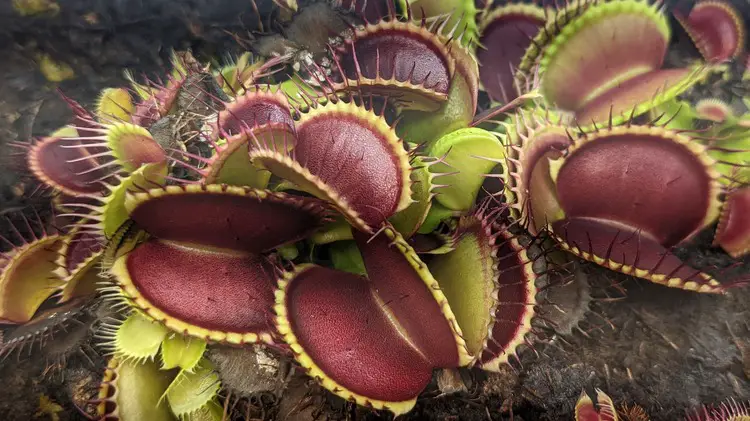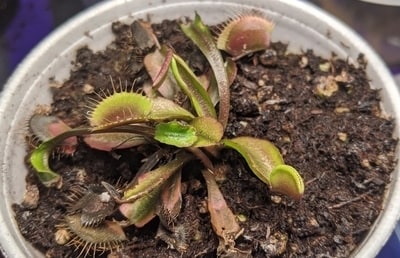Lighting is extremely important for Venus fly traps. Lack of proper sunlight or artificial light will have negative effects on your plant. In this article, I will cover some clear signs your Venus fly trap needs more light.
Venus fly traps need at least 4-6 hours of direct sunlight to survive. 12 hours of direct sunlight is optimal for Venus fly traps. When Venus fly traps are light starved, they often lose their colors and might even become deformed.
It is possible to grow Venus fly traps indoors without sunlight by using strong LED or fluorescent lights of at least 1500 lumens that run for 12- 16 hour daily cycles. This small LED plant light has worked for my Venus fly traps.

Even though many factors influence your plant’s health, improper lighting is one of the most common mistakes. Here are the signs your Venus Fly trap needs more lighting with tips to resolve.
The Venus fly trap is losing its colors
Most Venus fly traps characterize by bright green and deep red colors. Some cultivars will have lighter color schemes, but not the vast majority. If your plant is suddenly losing its colors and looking faded, it might be due to not enough lighting.
The Venus fly trap petioles are growing wide
Venus fly traps have long petioles that connect the root bulb with the trap of the plant. Sometimes the petioles start to grow wider and wider to increase their area. Wide petioles are usually a sign of poor lighting.
The plant is trying to grow wider leaves to have higher exposure to sunlight. The wider petioles won’t affect the plant immediately, but they are a sign that your plant is unhealthy. As soon as you introduce extra lighting, your plant should start growing more proportional petioles.
Venus fly traps are not producing traps
Under very poor growing conditions and lack of lighting, Venus fly traps will stop producing traps altogether.
The plant is suffering greatly and aims to focus on photosynthesis. It won’t produce any traps because capturing bugs is not a priority.
If your plant is not growing any traps, you must correct the environment. Place it under bright sunlight for a few hours a day and slowly introduce more lighting until you reach 10-12 hours. Your plant should start producing leaves as soon as it starts recovering.
The Venus flytrap is looking droopy and wilting
Venus fly traps droop for three main reasons: not enough water, lighting, or both! Assess the water and lighting when your plant is looking down.
Venus fly traps need to be watered often. The soil must remain humid at all times. Completely dry soil can harm Venus fly traps (you can find more information on watering here!)
Lack of lighting will also make your Venus fly trap wilt, but reintroducing it to light will bring your plant back to normal again.
Venus fly traps growing in Walmart or Home Depot are often droopy because they grow on dark shelves and are never watered.
The traps have lost all red coloring
Varieties of Venus fly trap have different shares of color inside the traps. Some have very deep burgundy shades, and others are all green.
When Venus fly traps have red coloring inside their traps, and they suddenly start losing it, it can be a sign of poor lighting. The red color inside the traps is designed to attract insects. When a Venus fly trap requires more light, it will stop worrying about capturing prey; therefore, it can stop producing traps with red shades.
The traps of the Venus fly trap stop working
Non-working traps are not always a sign of poor lighting, but they can certainly be. Venus flytraps often develop traps that do not close when triggered when they are dormant, have had a lot of stress, or are not receiving enough light.
Venus fly traps go dormant in the winter when exposed to weather below 45 F. While dormant, most traps might not work.
Shipping, repotting, or abrupt temperature changes can cause stress in your Venus flytrap that can consequentially make the traps stop working.
If you believe the traps in your plant are not working due to improper lighting, watch for additional signs to confirm before making abrupt changes in your plant’s environment.
The plant is losing leaves and reducing in size
When growing conditions are not optimal, Venus fly traps will stop dividing and stop producing as many leaves. In some cases, you might notice an abrupt reduction from having 6-8 healthy leaves to only a couple.
The small number of leaves is not always a sign of improper lighting but a sign of poor growing conditions. Assess the overall setup and check for the lighting and watering requirements with special attention.
Now that you have learned about the signs your Venus fly trap needs more light, it is time to fix the setup and provide appropriate lighting.
The recovery time will vary in length depending on the severity of the light starvation. Some plants can recover in just a few days, while others might take 4-5 weeks. A slight fade in color it’s a pretty mild sign. When a plant stops growing traps altogether, it’s a pretty serious sign.
First, start by learning more about the light requirements for Venus fly traps in this article: Venus Fly trap lighting requirements explained
Then, introduce your plant to more lighting slowly. Add one to two hours every couple of days if your plant is growing outside.
For indoor plants, consider placing the light source closer to your plant. LEDs can be mounted a few inches away from your plant without burning the leaves. I recommend bringing the lights closer by a couple of inches every few days until you reach the desired light exposure.
It is also possible that your artificial lights are not suitable for Venus fly traps. In this article, I share my recommendations for Venus fly trap plant lights and a guide to check the specs.
After you have increased the lighting, your Venus fly trap should start looking bright and happy again. For more care information, read this complete guide on growing Venus flytraps.


